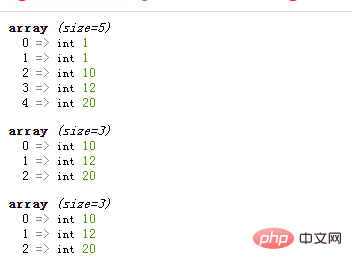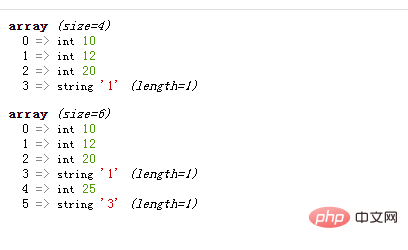Home >Backend Development >PHP Tutorial >Tips for learning PHP arrays and using functions to insert elements (2)
Tips for learning PHP arrays and using functions to insert elements (2)
- 青灯夜游Original
- 2021-08-04 15:44:552778browse
In the previous article "PHP Array Learning Skillful Use of Functions to Insert Elements (1)", we introduced two methods of adding new elements to the array. Use array_unshift() to add new elements to the array. To insert a new element at the beginning, use array_push() to insert a new element at the end of the array. Today we will continue to introduce the method of inserting new elements into the PHP array, and introduce two methods to you.
This article uses code examples to introduce the array_pad() and array_splice() functions to see how they insert new elements.
1. The array_pad() function inserts new elements into the array
array_pad($array,$size,$value) The function can insert a certain key value $value into the array $array, thereby filling the array to the specified length $size. (The $size parameter can be understood as the final number of elements in the array, that is, the length of the array after the insertion operation).
Let’s take a closer look at the following example:
<?php $arr=array(10,12,20); $result =array_pad($arr,5,1); var_dump($result); ?>
As can be seen from array_pad($arr,5,1), $size## The value of # is 5, then there are 5 elements in the array after the insertion operation; and there are 3 elements in the original array, then only 2 elements need to be inserted. And because the inserted value $value is 1, you only need to insert 2 elements with the value "1". Therefore, the output result is:

$size parameter. The
$size parameter has three values: if
- is a positive number, elements will be inserted at the end of the array; If
- is a negative number, insert the element at the beginning of the array;
- If its absolute value is less than or equal to the length of the
$array
array, no element will be inserted. Insert operation.
<?php $arr=array(10,12,20); $result =array_pad($arr,-5,1); var_dump($result); $result =array_pad($arr,3,1); var_dump($result); $result =array_pad($arr,2,1); var_dump($result); ?>The output result is:

$value can also be an array, that is Insert an entire array, and the original array will become a two-dimensional array.
<?php
header("Content-type:text/html;charset=utf-8");
$arr=array(10,12,20);
$result =array_pad($arr,-5,array("张三",25,"男"));
var_dump($result);
?>The output result is:

2. The array_splice() function inserts new elements into the array
array_splice($array,$start,$length,$value)The function is a powerful function that can be used to delete array elements, replace array elements, and also insert arrays element (just set the parameter $length to 0).
$length=0, then the parameter $start can specify the position (subscript) to start inserting, and the parameter $value can The insertion value can be specified (if there are multiple values, it needs to be set as an array).
<?php
header("Content-type:text/html;charset=utf-8");
$arr1=array(10,12,20);
array_splice($arr1,0,0,"1");
var_dump($arr1);
$arr2=array(10,12,20);
array_splice($arr2,0,0,array("1",25,"3"));
var_dump($arr2);
?>The output result is:

$start=0, the $value values will be inserted into the beginning of the array in order. So what do you do if you want to insert an element at the end of the array?
$start to "array length value", that is, count($arr).
<?php
header("Content-type:text/html;charset=utf-8");
$arr1=array(10,12,20);
array_splice($arr1,count($arr1),0,"1");
var_dump($arr1);
$arr2=array(10,12,20);
array_splice($arr2,count($arr2),0,array("1",25,"3"));
var_dump($arr2);
?>The output result is:

PHP function array array function video explanation, come and learn!
The above is the detailed content of Tips for learning PHP arrays and using functions to insert elements (2). For more information, please follow other related articles on the PHP Chinese website!

